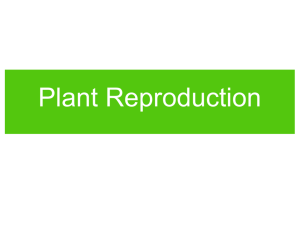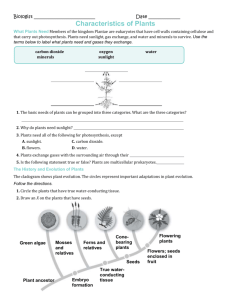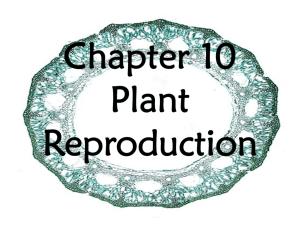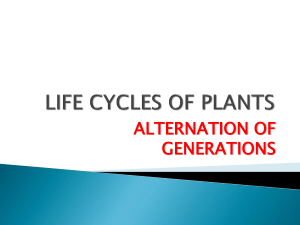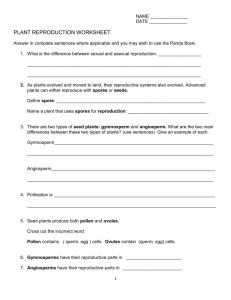Plant Reproduction
advertisement
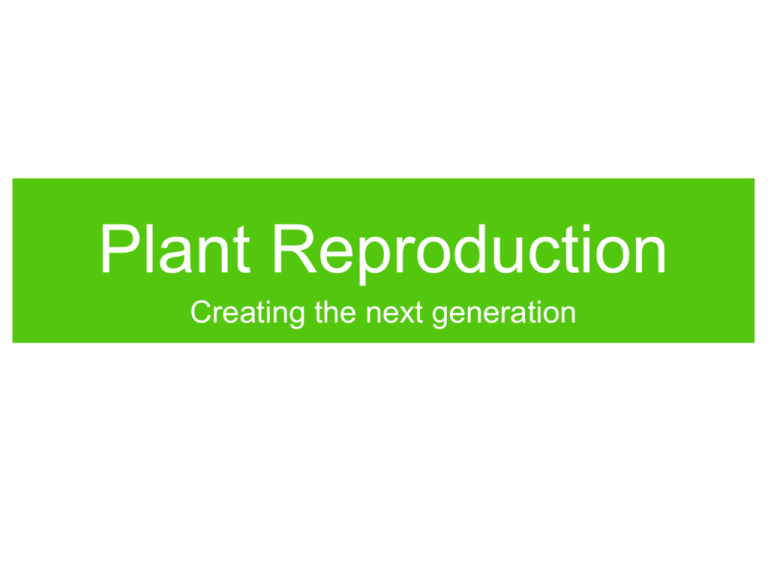
Plant Reproduction Creating the next generation W O R K • Is a seed alive? Is a fruit alive? Answer as completely as you can on your own paper. (Hang on to your paper until the end of class.) T O G E T H E R Asexual Reproduction • Asexual reproduction is natural “cloning.” Parts of the plant, such as leaves or stems, produce roots and become an independent plant. • List some benefits and some drawbacks to asexual reproduction. Sexual Reproduction • Sexual reproduction requires fusion of male cells in the pollen grain with female cells in the ovule. • List some advantages and drawbacks to sexual reproduction. Terms to know: • Haploid: having a single set of chromosomes in each cell. • Diploid: having two sets of chromosomes in each cell. • Mitosis: cell division, which produces two genetically identical cells. • Meiosis: reduction division, which produces four haploid reproductive cells. Plant Life Cycle Alternation of Generations • Plants have a double life cycle with two distinct forms: • Sporophyte: diploid, produce haploid spores by meiosis (reduction division). • Gametophyte: haploid, produce gametes by mitosis (simple cell division). Non-flowering plants • Mosses, ferns, and related plants have motile, swimming sperm. • What kind of environmental conditions would be required for reproduction in these plants? • What kinds of limits does external reproduction impose on these plants? Moss Life Cycle Fern Life Cycle Conifers • Conifers (also non-flowering plants) have reduced gametophytes. • Male gametophyte is contained in a dry pollen grain. • Female gametophyte is a few cells inside of the structures that become the seed. Conifer life cycle Conifer pollination • Conifers are wind-pollinated plants. • Chance allows some pollen to land on the scales of female cones. • Pollen germinates, grows a pollen tube into the egg to allow sperm to fertilize the egg. • What are some advantages and disadvantages to wind pollination? Animals vs. Plants Plant Reproduction Animal Reproduction Life cycle Alternation of generations No alternation of generations Gametes Haploid gametes Haploid gametes Spores Haploid spores No spores Gametes made Haploid gametophyte, by by mitosis Spores made by Diploid sporophyte, by meiosis Diploid organism, by meiosis No spores Meiosis produces cells that have: 1. Twice the number of chromosomes as the original cell. 2. The same number of chromosomes as the original cell. 3. Half the number of chromosomes as the original cell. 33% 1 33% 2 33% 3 A diploid sporophyte produces haploid spores. Which process did it use? 50% 50% 1. Meiosis 2. Mitosis 1 2 A haploid gametophyte produces: 25% 1. 2. 3. 4. 25% 25% 25% Diploid spores Haploid spores Diploid gametes Haploid gametes 1 2 3 4 Flowers Pollen go-betweens • Showy flowers are the result of selection for more efficient pollination strategies. • Flower parts are modified leaves. Those that were brightly colored attracted insects in search of pollen. • Why would insects search for pollen? What other rewards do flowers offer? • What are advantages and disadvantages to relying on insects as pollinators? Flower Parts Incomplete flowers • Flowers are complete if they have all parts, and perfect if they have both male and female parts. • Grass flowers: incomplete, usually imperfect (separate male and female flowers) • A tulip is complete (though the sepals are the same color as the petals) and perfect. Imperfect flowers Angiosperm Life Cycle Gametogenesis: Male Gametogenesis: Female Double Fertilization The male structures of a flower are the: 25% 1. 2. 3. 4. 25% 25% 25% Petals Sepals Carpels Stamens 1 2 3 4 A flower is perfect if it has: 25% 1. 2. 3. 4. 25% 25% 25% Anthers and carpels Petals and sepals Petals and carpels Sepals and stamens 1 2 3 4 The two sperm from the pollen help give rise to: 25% 25% 25% 25% 1. Petals and sepals 2. Stamens and pistils 3. Endosperm and embryo 4. Gametes and spores 1 2 3 4 Fruits From ovary to fruit • The ovary of the flower contains the ovules. • As fertilized ovules develop into seeds, the ovary wall develops into the fruit. • In science, the term “fruit” refers to a mature ovary that contains seeds. Flower to Fruit Types of dry fruits Capsule (Poppy) Legume (Bean pod) Silique (Money Plant) Follicle (Columbine) Achene (Sunflower) Nut (Hazelnut) Types of fleshy fruits Drupe (Peach) Berry (Tomato) Pome (Apple) Pepo (Cucumber) Aggregate (Strawberry) Multiple (Pineapple) Seeds arise directly from: 25% 1. 2. 3. 4. 25% 25% 25% Ovaries Ovules Pollen grains Anthers 1 2 3 4 Seeds Ovule to seed Seed Anatomy Seed anatomy Seed dormancy • Seeds can remain dormant in the soil for long periods of time. Dormancy helps ensure that seeds only germinate when conditions are right. • When we weed or cultivate a bare patch of soil, the weeds that sprout up immediately usually come from the “seed bank” already in the soil. Breaking dormancy • Seeds require moisture and the right temperature to germinate. • In addition, some seeds germinate only after certain environmental signals: • Drying • Temperature (period of cold or heat) • Disruption of the seed coat Seed Germination Cotyledons are: 25% 25% 25% 25% 1. Embryonic leaves 2. Structures that contain food for the embryo 3. Embryonic plants 4. The seed coat 1 2 3 4 W O R K • Use what you have learned about plant life cycles to explain why most mosses and ferns live in moist environments, but flowering plants can live just about anywhere. T O G E T H E R

